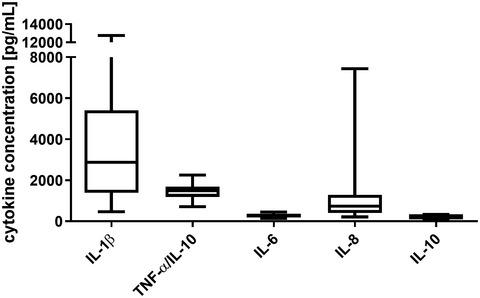当前位置:
X-MOL 学术
›
Clin. Exp. Immunol.
›
论文详情
Our official English website, www.x-mol.net, welcomes your
feedback! (Note: you will need to create a separate account there.)
Chronic bacterial pulmonary infections in advanced cystic fibrosis differently affect the level of sputum neutrophil elastase, IL-8 and IL-6
Clinical & Experimental Immunology ( IF 3.4 ) Pub Date : 2021-05-25 , DOI: 10.1111/cei.13624 Grzegorz Majka 1 , Henryk Mazurek 2 , Magdalena Strus 3 , Marta Ciszek-Lenda 1 , Rafał Szatanek 4 , Agnieszka Pac 5 , Edyta Golińska 3 , Janusz Marcinkiewicz 1
Clinical & Experimental Immunology ( IF 3.4 ) Pub Date : 2021-05-25 , DOI: 10.1111/cei.13624 Grzegorz Majka 1 , Henryk Mazurek 2 , Magdalena Strus 3 , Marta Ciszek-Lenda 1 , Rafał Szatanek 4 , Agnieszka Pac 5 , Edyta Golińska 3 , Janusz Marcinkiewicz 1
Affiliation

|
Advanced cystic fibrosis (CF) lung disease is commonly characterized by a chronic Pseudomonas aeruginosa infection and destructive inflammation caused by neutrophils. However, the lack of convincing evidence from most informative biomarkers of severe lung dysfunction (SLD-CF) has hampered the formulation of a conclusive, targeted diagnosis of CF. The aim of this study was to determine whether SLD-CF is related to the high concentration of sputum inflammatory mediators and the presence of biofilm-forming bacterial strains. Forty-one patients with advanced CF lung disease were studied. The severity of pulmonary dysfunction was defined by forced expiratory volume in 1 second (FEV1) < 40%. C-reactive protein (CRP) and NLR (neutrophil–lymphocyte ratio) were examined as representative blood-based markers of inflammation. Expectorated sputum was collected and analysed for cytokines and neutrophil-derived defence proteins. Isolated sputum bacteria were identified and their biofilm-forming capacity was determined. There was no association between FEV1% and total number of sputum bacteria. However, in the high biofilm-forming group the median FEV1 was < 40%. Importantly, high density of sputum bacteria was associated with increased concentrations of neutrophil elastase and interleukin (IL)-8 and low concentrations of IL-6 and IL-10. The low concentration of sputum IL-6 is unique for CF and distinct from that observed in other chronic pulmonary inflammatory diseases. These findings strongly suggest that expectorated sputum is an informative source of pulmonary biomarkers representative for advanced CF and may replace more invasive bronchoalveolar lavage analysis to monitor the disease. We recommend to use of the following inflammatory biomarkers: blood CRP, NLR and sputum elastase, IL-6, IL-8 and IL-10.
中文翻译:

晚期囊性纤维化慢性细菌性肺部感染对痰中性粒细胞弹性蛋白酶、IL-8 和 IL-6 水平的影响不同
晚期囊性纤维化 (CF) 肺病通常以慢性铜绿 假单胞菌为特征中性粒细胞引起的感染和破坏性炎症。然而,严重肺功能障碍 (SLD-CF) 的大多数信息生物标志物缺乏令人信服的证据,这阻碍了 CF 结论性、针对性诊断的制定。本研究的目的是确定 SLD-CF 是否与高浓度的痰炎症介质和生物膜形成细菌菌株的存在有关。研究了 41 名患有晚期 CF 肺病的患者。肺功能障碍的严重程度定义为 1 秒用力呼气量 (FEV1) < 40%。C 反应蛋白 (CRP) 和 NLR (中性粒细胞 - 淋巴细胞比率) 被检查为具有代表性的基于血液的炎症标志物。收集咳出的痰液并分析细胞因子和中性粒细胞衍生的防御蛋白。鉴定了分离的痰细菌并确定了它们的生物膜形成能力。FEV1%与痰细菌总数之间没有关联。然而,在高生物膜形成组中,中位 FEV1 < 40%。重要的是,高浓度的痰细菌与中性粒细胞弹性蛋白酶和白细胞介素 (IL)-8 浓度增加以及 IL-6 和 IL-10 浓度降低有关。低浓度的痰液 IL-6 是 CF 所特有的,与在其他慢性肺部炎症疾病中观察到的不同。这些发现有力地表明,咳出的痰液是代表晚期 CF 的肺部生物标志物的信息来源,可能会取代更具侵入性的支气管肺泡灌洗分析来监测疾病。我们建议使用以下炎症生物标志物:血液 CRP、
更新日期:2021-05-25
中文翻译:

晚期囊性纤维化慢性细菌性肺部感染对痰中性粒细胞弹性蛋白酶、IL-8 和 IL-6 水平的影响不同
晚期囊性纤维化 (CF) 肺病通常以慢性铜绿 假单胞菌为特征中性粒细胞引起的感染和破坏性炎症。然而,严重肺功能障碍 (SLD-CF) 的大多数信息生物标志物缺乏令人信服的证据,这阻碍了 CF 结论性、针对性诊断的制定。本研究的目的是确定 SLD-CF 是否与高浓度的痰炎症介质和生物膜形成细菌菌株的存在有关。研究了 41 名患有晚期 CF 肺病的患者。肺功能障碍的严重程度定义为 1 秒用力呼气量 (FEV1) < 40%。C 反应蛋白 (CRP) 和 NLR (中性粒细胞 - 淋巴细胞比率) 被检查为具有代表性的基于血液的炎症标志物。收集咳出的痰液并分析细胞因子和中性粒细胞衍生的防御蛋白。鉴定了分离的痰细菌并确定了它们的生物膜形成能力。FEV1%与痰细菌总数之间没有关联。然而,在高生物膜形成组中,中位 FEV1 < 40%。重要的是,高浓度的痰细菌与中性粒细胞弹性蛋白酶和白细胞介素 (IL)-8 浓度增加以及 IL-6 和 IL-10 浓度降低有关。低浓度的痰液 IL-6 是 CF 所特有的,与在其他慢性肺部炎症疾病中观察到的不同。这些发现有力地表明,咳出的痰液是代表晚期 CF 的肺部生物标志物的信息来源,可能会取代更具侵入性的支气管肺泡灌洗分析来监测疾病。我们建议使用以下炎症生物标志物:血液 CRP、









































 京公网安备 11010802027423号
京公网安备 11010802027423号